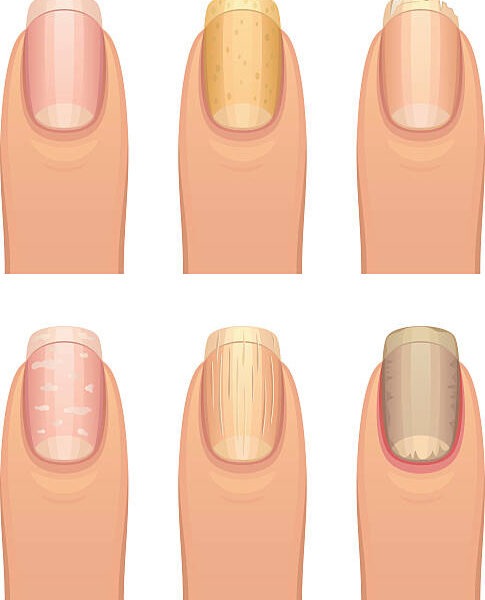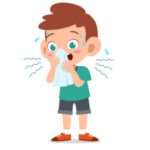Changes in the appearance, shape, texture, or thickness of the fingernails or toenails are referred to as nail changes. Nail changes can have various causes, such as infections, injuries, diseases, or aging. Nail changes can also indicate underlying health problems, such as nutritional deficiencies, diabetes, thyroid disorders, or cancer. Nail changes can cause cosmetic concerns, discomfort, pain, or difficulty in performing daily activities. Nail changes can usually be treated with medications, home remedies, or lifestyle modifications, but sometimes they may require medical attention.
Types of Nail Changes
There are many different types of nail changes, depending on their appearance and cause. Some of the common types are:
• Nail discoloration. This is a change in the color of the nails, such as white spots, yellowing, darkening, or streaks. Nail discoloration can be caused by various factors, such as fungal infections, nail polish, smoking, medications, liver disease, kidney disease, or melanoma (a type of skin cancer).
• Nail ridges. These are vertical or horizontal lines or grooves on the surface of the nails. Nail ridges can be caused by various factors, such as aging, trauma, nail biting, psoriasis (a skin condition), eczema (a skin condition), anemia (low red blood cell count), or malnutrition.
• Nail splitting. This is a condition where the nails become brittle and break easily. Nail splitting can be caused by various factors, such as dryness, exposure to chemicals or water, fungal infections, thyroid disorders, or iron deficiency.
• Nail pitting. This is a condition where the nails have small depressions or holes on the surface. Nail pitting can be caused by various factors, such as psoriasis (a skin condition), alopecia areata (a hair loss condition), lichen planus (a skin condition), eczema (a skin condition), or reactive arthritis (a joint inflammation condition).
• Nail clubbing. This is a condition where the nails become curved and enlarged at the tips. Nail clubbing can be caused by various factors, such as chronic low oxygen levels in the blood due to lung disease, heart disease, liver disease, inflammatory bowel disease (IBD), or AIDS.
• Nail spooning. This is a condition where the nails become concave and thin at the center. Nail spooning can be caused by various factors, such as iron deficiency anemia (low red blood cell count), hemochromatosis (excess iron in the body), Raynaud’s disease (a blood vessel disorder), lupus (an autoimmune disease), or hypothyroidism (low thyroid hormone levels).
Symptoms of Nail Changes
Nail changes can have various symptoms, depending on the type and cause of the change.
Some common symptoms that may accompany nail changes are:
• Pain. The nail change may cause pain or tenderness in the nail bed or around the nail fold. Pain can make it difficult to use the fingers or toes for daily activities.
• Inflammation. The nail change may cause redness, swelling, or warmth in the nail bed or around the nail fold. Inflammation can indicate infection, irritation, or allergy.
• Bleeding. The nail change may cause bleeding under the nail plate or around the nail fold. Bleeding can indicate trauma, infection, or cancer.
• Foul odor. The nail change may cause a foul odor from the nail bed or around the nail fold. Foul odor can indicate infection, decay, or gangrene.
Diagnosis of Nail Changes
To diagnose the cause of nail changes, a doctor will usually perform a physical examination and ask about the history and symptoms of the condition. The doctor may also order some tests to confirm the diagnosis or rule out other possible causes. Some of these tests are:
• Nail clipping. This involves taking a small sample of the nail plate and sending it to a laboratory for further testing. This can help identify the type and cause of infection, such as fungus, bacteria, or parasite.
• Nail biopsy. This involves taking a small sample of the nail bed or nail fold using a scalpel or a needle and examining it under a microscope or sending it to a laboratory for further testing. This can help identify the type and cause of inflammation, abnormality, or cancer in the tissue.
• Blood test. This involves drawing a sample of blood from a vein and measuring the levels of certain substances in the blood that may indicate inflammation, infection, autoimmunity, or metabolic disorders. Examples of blood tests include complete blood count (CBC), erythrocyte sedimentation rate (ESR), C-reactive protein (CRP), rheumatoid factor (RF), antinuclear antibody (ANA), iron, glucose, and thyroid hormones.
Treatment of Nail Changes
The treatment of nail changes depends on its cause, severity, and impact on daily life. The main goals of treatment are to relieve symptoms, treat the underlying condition, and improve the appearance of the nails. Some common treatments for nail changes are:
• Medications. These can help treat infections, inflammations, or diseases that cause nail changes. They can be taken orally, applied topically, or injected into the nail bed or nail fold. Examples of medications include antifungals for fungal infections, antibiotics for bacterial infections, antiparasitics for parasitic infections, corticosteroids for inflammatory conditions, immunosuppressants for autoimmune diseases, biologics for cancer, and supplements for nutritional deficiencies.
• Nail care. This involves keeping the nails clean, dry, and trimmed to prevent further damage or infection. It also involves avoiding nail polish, artificial nails, or harsh chemicals that can worsen nail changes. It may also involve wearing gloves or protective footwear to protect the nails from trauma or exposure to water or irritants.
• Cosmetic procedures. These can help improve the appearance of the nails by covering up or removing nail changes. They can include nail polish, artificial nails, nail wraps, nail fillers, nail surgery, or laser therapy.
Home Remedies for Nail Changes
In addition to medical treatment, there are some home remedies that can help ease nail changes and improve nail health.
Some of these are:
• Apple cider vinegar. Applying apple cider vinegar to the nails can help fight fungal infections due to its acidic and antifungal properties. It can also help restore the pH balance of the nails and prevent further growth of fungi.
• Tea tree oil. Applying tea tree oil to the nails can help treat bacterial and fungal infections due to its antibacterial and antifungal properties. It can also help reduce inflammation and pain in the nails.
• Coconut oil. Applying coconut oil to the nails can help moisturize and nourish the nails due to its fatty acids and antioxidants. It can also help prevent fungal infections due to its antifungal properties.
• Biotin. Taking biotin supplements or eating biotin-rich foods such as eggs, nuts, seeds, dairy products, or meat can help strengthen and grow the nails due to its role in keratin production. Keratin is the protein that makes up the nails.
When to See a Doctor
Nail changes are usually not a medical emergency, but they can be a sign of a serious condition that requires prompt diagnosis and treatment. Some situations when it is advisable to see a doctor for nail changes are:
• The nail change is severe, sudden, or unexplained.
• The nail change is accompanied by fever, chills, rash, weight loss, or other signs of infection or systemic illness.
• The nail change is caused by an injury that results in bleeding, infection, or deformity.
• The nail change persists for more than two weeks despite home remedies and OTC medications.
• The nail change interferes with daily activities and quality of life.
Summary
Nail changes are changes in the appearance, shape, texture, or thickness of the fingernails or toenails. Nail changes can have various causes, such as infections, injuries, diseases, or aging. Nail changes can also indicate underlying health problems, such as nutritional deficiencies, diabetes, thyroid disorders, or cancer. Nail changes can cause cosmetic concerns, discomfort, pain, or difficulty in performing daily activities. Nail changes can usually be treated with medications, home remedies, or lifestyle modifications, but sometimes they may require medical attention. In this blog post, we explored some of the common types, causes, symptoms, and treatments for nail changes.



